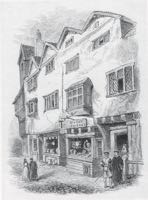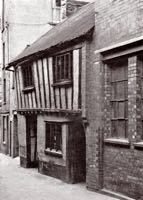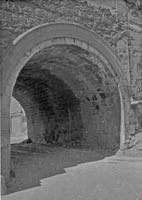
Frog Street
Page updated 31st July 2020
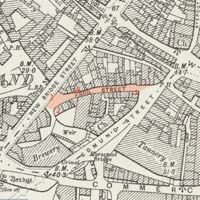 Before Western Way was built in 1961, Frog Street ran from the Exe
Island tunnel under New Bridge Street to the top end of Edmund Street.
According to Hoskins, It was so named after the many frogs that
frequented the marshy ground which originally lived on the marshy
banks of the Exe. From the 15th Century, Frog Street was lined with
merchant houses, inhabited by merchants, and wealthy fullers from the
mills.
Before Western Way was built in 1961, Frog Street ran from the Exe
Island tunnel under New Bridge Street to the top end of Edmund Street.
According to Hoskins, It was so named after the many frogs that
frequented the marshy ground which originally lived on the marshy
banks of the Exe. From the 15th Century, Frog Street was lined with
merchant houses, inhabited by merchants, and wealthy fullers from the
mills.
The 1832 cholera outbreak was relatively kind to Frog Street as only 5 deaths were recorded, one of which was off the street. Although the practice of dipping for water from the leats had ceased, in 1879, Frog Street residents still obtained water from wells. The Sanitary Committee ordered one well at Day's Court, Frog Street to be closed after water analysis found it to be contaminated. In the same year, the Streets Committee recommended a public fountain be provided in Frog Street by the tunnel. Typhoid was still a regular visitor to the city, and more effort was being applied to eradicating it. St Edmund's School was on the south side of Frog Street-it had a tiny playground wedged between the school, St Edmund's Church and other buildings.
Overcrowding and poverty
The loss of the woollen trade saw many of the 'so called' merchant's houses turned into tenements for the poor. In 1885, a Royal Commission into working class housing visited Exeter. They found in Frog Street a house with 27 beds in six rooms, of which the largest was 13ft by 13ft. The night they inspected the house, some beds were empty, but there were still 17 adults and 10 children sleeping. Another room had seven children in two beds, occupying it, ranging in age from infancy to 14 or 15 year old girls-sometimes a man and woman slept in a third bed. There was no ventilation and no chimney.
The Round Tree Inn was close to the Round Tree Mill, on the opposite side of the Lower Leat, to the south of the map; the mill was formerly Cuckingstool Mill. The inn was mentioned as early as 1727, in an advert in Brice's Weekly, and ceased trading in 1903. The mill was burnt down in 1910. The inn became a bottle store for the City Brewery, and is in one of the photos.
Drunkenness was a problem in 19th Century Exeter, and a temperance society opened the Pioneer Westgate Coffee Tavern at the top end of the street, opposite the Merchant's House, to encourage people to socialise there rather than in the local pubs. Opened in 1882, the premises had a hall, and a bar serving tea, cocoa and coffee. They served dinners in the hall, and they also had a reading room where daily newspapers could be accessed.
The House that Moved
The most famous building in Frog Street was the Merchants House, which was moved, on iron wheels to the bottom of West Street, a distance of approximately 90 metres. See the House that Moved photo essay which includes a BBC film of the move.
At the time that the Merchant House was saved from demolition, No., 15 Frog Street was demolished in the summer of 1961. Dating from the early Elizabethan years, it was equally historic, and in some ways more unique because the gabled roof was parallel to the street, probably because there was more frontage available outside the confines of the city. A timber framed house, it had a single ground floor 'hall' off the passage way that ran through the building from the street to a small yard at the rear. The oversailing first floor contained two chambers divided by a stud partition wall.
Demolition
Frog Street disappeared in 1963 when all its buildings had been demolished and the new road that passed under an enlarged Exe Island tunnel, was constructed along the edge of the City Wall above Cricklepit Lane. The City Council minutes for July of that year, record the formal change of the name to Western Way. After Western Way was completed, a garage and car showroom was built for A J Beal, which was Wadham Stringer by 1979. It housed Comet in 1983/4, and more recently Radmore and Tucker. The company have moved to near Ide, and the evacuated site has been replaced by luxury student accommodation. So from fullers and merchants, through the cholera, Frog Street now is home to students.
White's Devonshire Directory of 1850, lists the following trades in the street.
Beerhouse - Lee
Susanna
Baker - Barrett Matthew, and Mortimer Wm.
Blacksmith - Underhill Wm.
Builder - Morton Wm.
Coach Builder - Powlesland Robert
Fruiterers and Green Grocers - Penberthy Jas.
Hotels Inns and Taverns - The Round Tree, Mary Morton
Marine Store Dealers - Vigers Joseph
Shopkeeper - Griffin Nicholas Tallow
Chandlers - Wills Wm.
The list gives an indication of the diversity of commerce that the street supported.
Source: Various sources including GENUKI (White's), Aspect of Exeter by Peter Thomas and Jacqueline Warren, Exeter Houses by D Portman and the British Newspaper Archive.
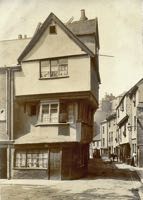
The Merchant's House (1) stood on the corner of Frog Street for hundreds of years. Of course it is best known as the 'House that Moved'.
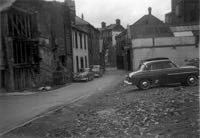
This photo was taken when demolition had started. The photographer is standing on the opposite corner to the Merchant's House. Photo Dick Passmore.
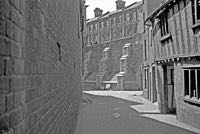
Further down the street came into view New Bridge Street. The Exe Island tunnel is on the right, just beyond the last house.
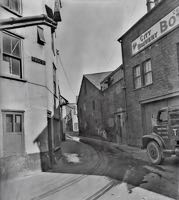
Looking back up the street from the tunnel. The city brewery had a bottle store (2) on the right, that was formerly the Round Tree Inn.
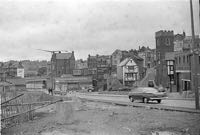
Looking down Western Way just after the road was finished. The bridge replaced the tunnel. Photo Michael Wride.
Courts off Frog Street
Day's Court
Priddey's Court
Roper's Court
Taylor's Court
? Top of Page ?
